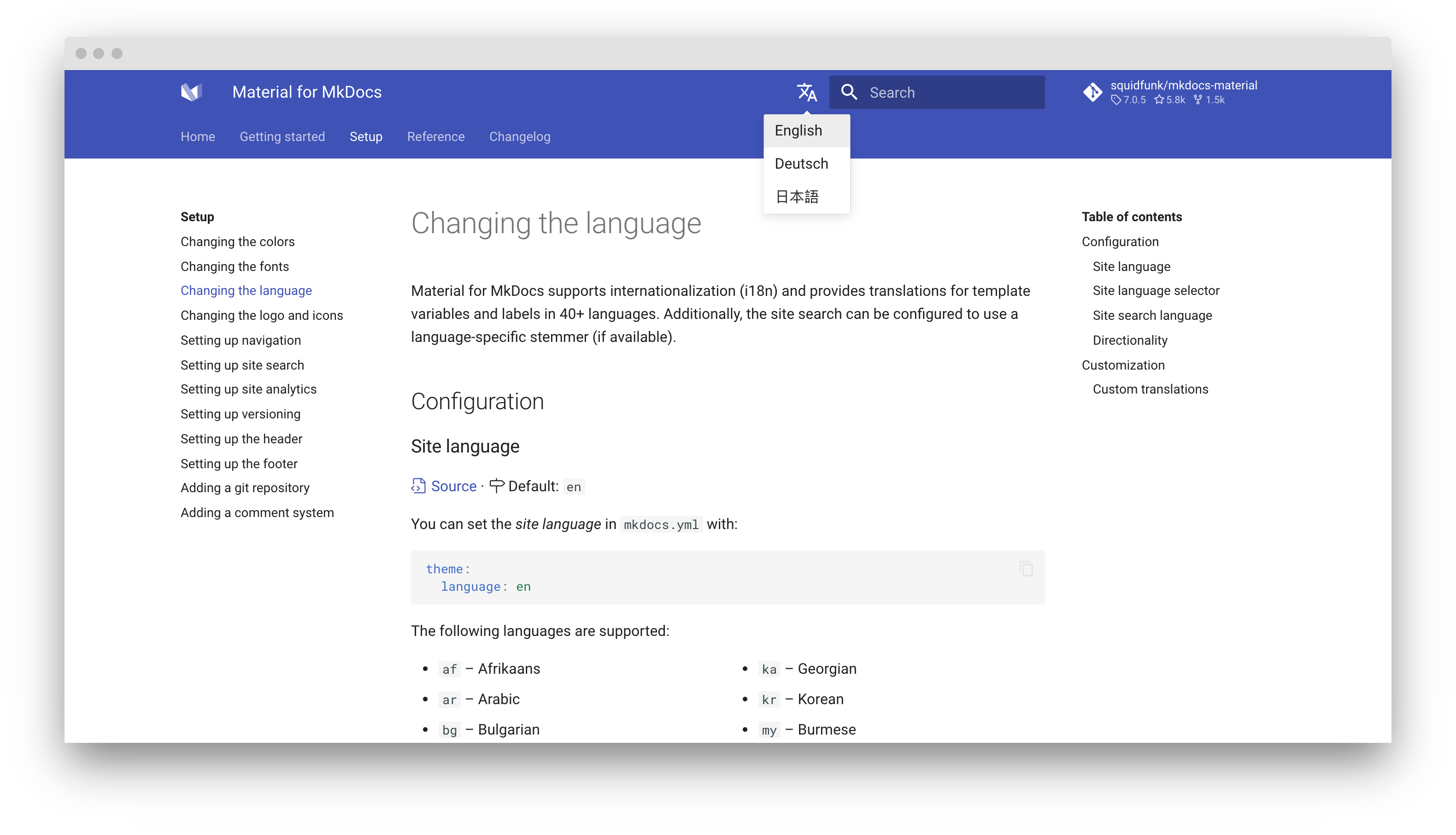5.9 KiB
Changing the language
Material for MkDocs supports internationalization (i18n) and provides translations for template variables and labels in 60+ languages. Additionally, the site search can be configured to use a language-specific stemmer, if available.
Configuration
Site language
You can set the site language in mkdocs.yml with:
theme:
language: en # (1)!
-
HTML5 only allows to set a single language per document, which is why Material for MkDocs only supports setting a canonical language for the entire project, i.e. one per
mkdocs.yml.The easiest way to build a multi-language documentation is to create one project in a subfolder per language, and then use the language selector to interlink those projects.
The following languages are supported:
Note that some languages will produce unreadable anchor links due to the way the default slug function works. Consider using a Unicode-aware slug function.
!!! tip "Translations missing? Help us out, it takes only 5 minutes"
Material for MkDocs relies on outside contributions for adding and updating
translations for the almost 60 languages it supports. If your language shows
that some translations are missing, click on the link to add them. If your
language is not in the list, click here to [add a new language].
Site language selector
If your documentation is available in multiple languages, a language selector
pointing to those languages can be added to the header. Alternate languages
can be defined via mkdocs.yml.
extra:
alternate:
- name: English
link: /en/ # (1)!
lang: en
- name: Deutsch
link: /de/
lang: de
- Note that this must be an absolute link. If it includes a domain part, it's
used as defined. Otherwise the domain part of the
site_urlas set inmkdocs.ymlis prepended to the link.
The following properties are available for each alternate language:
: This value of this property is used inside the language selector as the name of the language and must be set to a non-empty string.
: This property must be set to an absolute link, which might also point to another domain or subdomain not necessarily generated with MkDocs.
:
This property must contain an ISO 639-1 language code and is used for
the hreflang attribute of the link, improving discoverability via search
engines.
Directionality
While many languages are read ltr (left-to-right), Material for MkDocs also
supports rtl (right-to-left) directionality which is deduced from the
selected language, but can also be set with:
theme:
direction: ltr
Click on a tile to change the directionality:
ltr
rtl
Customization
Custom translations
If you want to customize some of the translations for a language, just follow
the guide on theme extension and create a new partial in the overrides
folder. Then, import the translations of the language as a fallback and only
adjust the ones you want to override:
=== ":octicons-file-code-16: overrides/partials/languages/custom.html"
``` html
<!-- Import translations for language and fallback -->
{% import "partials/languages/de.html" as language %}
{% import "partials/languages/en.html" as fallback %} <!-- (1)! -->
<!-- Define custom translations -->
{% macro override(key) %}{{ {
"source.file.date.created": "Erstellt am", <!-- (2)! -->
"source.file.date.updated": "Aktualisiert am"
}[key] }}{% endmacro %}
<!-- Re-export translations -->
{% macro t(key) %}{{
override(key) or language.t(key) or fallback.t(key)
}}{% endmacro %}
```
1. Note that `en` must always be used as a fallback language, as it's the
default theme language.
2. Check the [list of available languages], pick the translation you want
to override for your language and add them here.
=== ":octicons-file-code-16: mkdocs.yml"
``` yaml
theme:
language: custom
```
